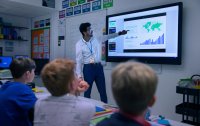Innovating Without Abandoning What Works
Ideas on how teachers and school leaders can preserve time-tested teaching practices while working to incorporate new good ideas.
Your content has been saved!
Go to My Saved Content.Tell me if this sounds familiar: A consultant or speaker came to your school or a conference you attended to talk about an amazing new teaching approach—maybe it was project-based learning, genius hour, STEM, flipped classrooms, or makerspaces. They went on and on about how successful this innovative strategy was in their own classroom—and how we need to abolish all the outdated teaching practices we’ve been using and replace them with this new one, which is the greatest pedagogical approach of all time.
And perhaps while they were showing pictures from their classroom of kids building race cars, swiveling around on thousand-dollar office chairs, and making keychains with a 3D printer, you couldn’t help but think about the desks in your classroom that have been there since before the moon landing. Or the fact that you haven’t been given a supply budget in four years, and that the only race cars your students are building are made out of toilet paper rolls you brought from home.
And you might have teaching practices you’ve used for many years—because they work—and you don’t want to throw them out just because a new fad is making its way through the education circuit.
These are all realities that are often ignored when we talk about innovation in education. Teachers are often sold the idea that it’s all or nothing: Flip your entire classroom to project-based learning or you’re doing it wrong. Convert the entire library to a makerspace or you’re doing your students a disservice. Never give another lecture again or you’re an “old-school” teacher who can’t effectively teach this generation.
Innovate—Without Abandoning What Works
But we shouldn’t dismiss innovation altogether. Rather, we should strive for balance: As we innovate, we have to be careful that we don’t discard methods that work. Here are some approaches that have worked for me.
Blend traditional practices with new ones: Innovation doesn’t require abandoning every trace of your former classroom. For instance, project-based learning (PBL) uses traditional practices to teach students to solve real problems. The real innovation in PBL is using an authentic audience—rather than grades—to motivate students.
Because of this, many of the lessons in a PBL unit might still look traditional. For instance, you could teach persuasive writing by having your students write letters to politicians advocating for a cause. You’re still teaching ethos, pathos, and logos—only now, there’s an authentic audience to heighten student engagement.
Focus on the skill, not the technology: Chances are, most students will not use 3D printers or video editing software in their future careers. Does this mean we shouldn’t use these tools in the classroom?
Not exactly. When deciding whether to use technology, educators should first ask whether it teaches transferable skills—not just how to use that technology. If using a 3D printer is an effective way to teach students how to conceptualize an idea, then by all means use it. If using video editing software is an effective way to teach organization skills and present complex ideas, then it’s worthwhile.
Provide support for educators to innovate: One of the best indicators of student success is teacher support. When teachers have what they need and don’t have to innovate alone, they are much more likely to succeed. This is why it’s crucial that administrators and other school leaders support teachers in their attempts to innovate.
School leaders should give leeway and allow failure as long as everyone is willing to learn from it. Create professional development that properly addresses teachers’ needs. Invest in online courses on how to use makerspaces successfully. Provide time for peer-to-peer learning labs, where teachers can observe their peers teach and take best practices back to their own classrooms.
An all-or-nothing approach to innovation can be intimidating—and it’s not generally beneficial. When we instead choose to work within realistic confines while seeking to use best practices with students, we will see our confines expand. Of course, the education system needs an overhaul in many areas, and many schools are stuck in the past. But real change happens from within, and that will only happen when change is actually possible.
